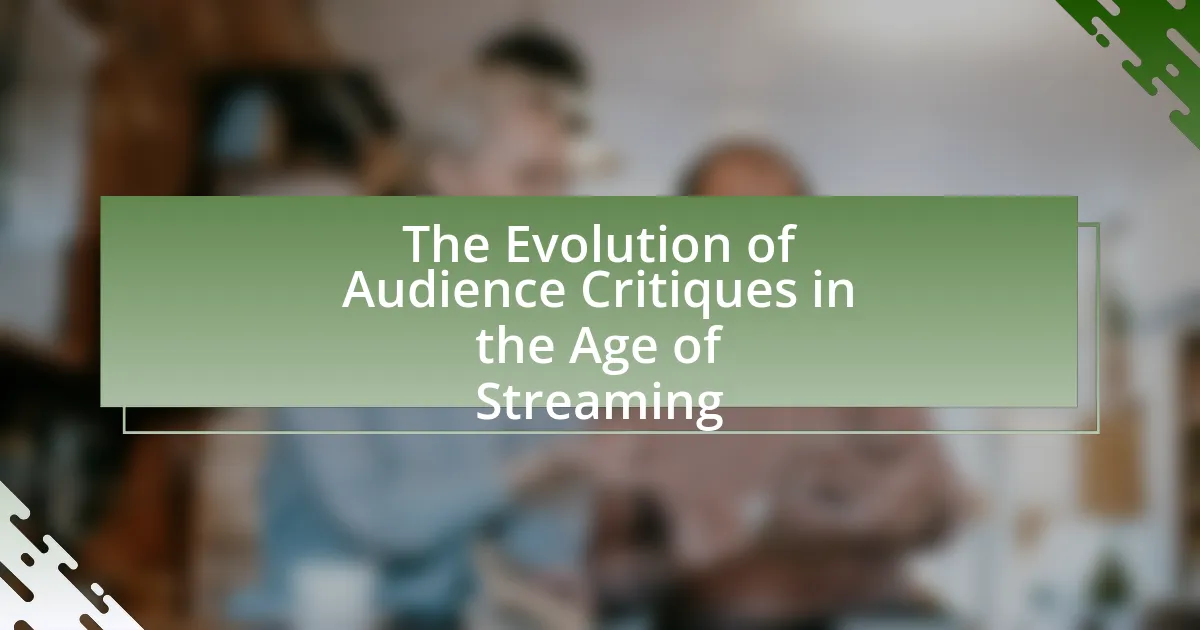The article delves into the psychology behind audience ratings, highlighting the influence of social proof, cognitive biases, and emotional responses on how viewers evaluate content. It examines the impact of audience ratings on media consumption, decision-making in production, and marketing strategies, emphasizing the importance of understanding viewer preferences and behaviors. Additionally, the article discusses the methodologies for measuring ratings, the biases that can distort perceptions, and the evolving nature of audience ratings in response to societal norms and technological advancements. Key components such as viewership numbers, demographic insights, and engagement metrics are also outlined, providing a comprehensive overview of how audience ratings shape the media landscape.

What is the Psychology Behind Audience Ratings?
The psychology behind audience ratings is primarily influenced by social proof, cognitive biases, and emotional responses. Social proof suggests that individuals often look to the opinions of others when forming their own judgments, leading to a bandwagon effect where popular ratings can sway new viewers. Cognitive biases, such as the halo effect, can cause audiences to rate content more favorably based on a single positive aspect, like a well-known actor or a high production value. Emotional responses also play a crucial role; viewers often rate content based on how it resonates with their feelings, which can lead to ratings that reflect personal experiences rather than objective quality. Research indicates that these psychological factors significantly impact how ratings are formed and perceived, demonstrating that audience ratings are not solely based on content quality but are deeply intertwined with human psychology.
How do audience ratings influence media consumption?
Audience ratings significantly influence media consumption by shaping viewer perceptions and choices. High ratings often indicate quality or popularity, prompting consumers to select those media offerings over others. For instance, a Nielsen report shows that programs with higher ratings attract larger audiences, as viewers tend to gravitate towards content that is perceived as widely accepted or endorsed by peers. This phenomenon is driven by social proof, where individuals rely on the ratings as a heuristic to determine what is worth watching, thereby reinforcing the cycle of consumption for high-rated media.
What psychological factors drive audience ratings?
Psychological factors that drive audience ratings include emotional engagement, social influence, and cognitive biases. Emotional engagement occurs when content resonates with viewers on a personal level, leading to increased ratings; for example, shows that evoke strong feelings, such as joy or sadness, tend to attract larger audiences. Social influence plays a significant role, as individuals often rely on peer recommendations and trends, which can enhance ratings for popular programs. Cognitive biases, such as the bandwagon effect, where people are more likely to engage with content that others are watching, also contribute to higher ratings. Research indicates that these factors collectively shape viewer preferences and behaviors, ultimately impacting audience ratings significantly.
How do social influences affect audience perceptions of ratings?
Social influences significantly shape audience perceptions of ratings by creating a context in which individuals interpret and evaluate information. For instance, when people observe others’ opinions or ratings, they often adjust their own perceptions to align with the majority, a phenomenon known as social conformity. Research indicates that 70% of individuals are influenced by the ratings and reviews of their peers, as highlighted in a study published in the Journal of Consumer Research by authors such as Chevalier and Mayzlin. This tendency is further amplified in online environments where visibility of ratings and comments can lead to herd behavior, ultimately affecting individual decision-making and overall audience perception of a product or service.
Why are audience ratings important for content creators?
Audience ratings are crucial for content creators because they provide direct feedback on audience preferences and engagement levels. This feedback helps creators understand what resonates with their audience, guiding future content development. For instance, a study by Nielsen found that 70% of viewers rely on ratings and reviews to decide what to watch, indicating that high ratings can significantly influence viewership and success. Additionally, audience ratings can enhance a creator’s credibility and attract partnerships or sponsorships, as brands often seek to collaborate with creators who have a proven track record of engaging content.
How do ratings impact decision-making in media production?
Ratings significantly influence decision-making in media production by guiding content development, marketing strategies, and financial investments. Producers and networks analyze audience ratings to determine which genres, themes, or formats resonate with viewers, leading to the continuation or cancellation of shows. For instance, a series with high ratings often receives additional funding for future seasons, while low-rated programs may be quickly axed. According to a 2020 Nielsen report, shows with higher ratings attract more advertising revenue, reinforcing the importance of audience feedback in shaping production choices. Thus, ratings serve as a critical metric for assessing viewer engagement and directing the strategic direction of media projects.
What role do audience ratings play in marketing strategies?
Audience ratings significantly influence marketing strategies by providing insights into consumer preferences and behaviors. Marketers utilize audience ratings to identify target demographics, tailor content, and optimize advertising placements. For instance, a Nielsen report indicates that 70% of advertisers adjust their campaigns based on audience ratings, ensuring that their messaging resonates with viewers. This data-driven approach enhances engagement and increases the likelihood of conversion, demonstrating the critical role audience ratings play in shaping effective marketing strategies.

What are the key components of audience ratings?
The key components of audience ratings include viewership numbers, demographic information, engagement metrics, and feedback mechanisms. Viewership numbers quantify how many people are watching a program, while demographic information provides insights into the age, gender, and location of the audience, which helps in understanding who is consuming the content. Engagement metrics, such as time spent watching and interaction rates, indicate how invested the audience is in the program. Feedback mechanisms, including surveys and social media reactions, offer qualitative insights into audience preferences and satisfaction. These components collectively inform content creators and advertisers about audience behavior and preferences, enabling targeted strategies for programming and marketing.
How are audience ratings measured?
Audience ratings are measured primarily through surveys, viewer panels, and digital tracking. Surveys collect data from a sample of viewers about their viewing habits and preferences, while viewer panels consist of selected participants who represent a broader audience demographic, providing insights into their viewing behavior. Digital tracking involves monitoring online streaming and viewing data through platforms that analyze user interactions, such as clicks and watch time. For instance, Nielsen, a leading audience measurement company, utilizes a combination of these methods to provide accurate ratings for television programs, reporting that they track over 40,000 households to gauge viewing patterns.
What methodologies are used to collect audience ratings data?
Quantitative and qualitative methodologies are used to collect audience ratings data. Quantitative methods include surveys, where structured questionnaires gather numerical data on audience preferences and behaviors, and electronic measurement tools like people meters that track viewing habits in real-time. Qualitative methods involve focus groups and interviews that provide in-depth insights into audience perceptions and motivations. For instance, Nielsen employs both electronic measurement and surveys to compile comprehensive ratings data, ensuring a robust understanding of audience engagement.
How do different platforms affect audience rating systems?
Different platforms significantly influence audience rating systems by shaping user engagement, accessibility, and feedback mechanisms. For instance, streaming services like Netflix utilize algorithms that prioritize user preferences, leading to ratings that reflect personalized viewing habits. In contrast, social media platforms such as Twitter allow for real-time audience feedback, which can skew ratings based on trending topics rather than content quality. Research indicates that platforms with higher interactivity, like YouTube, often see more polarized ratings due to the immediate nature of user comments and likes, which can amplify extreme opinions. This variance in audience interaction across platforms ultimately alters how ratings are perceived and aggregated, impacting overall audience sentiment and content visibility.
What biases can affect audience ratings?
Audience ratings can be affected by several biases, including confirmation bias, social desirability bias, and the bandwagon effect. Confirmation bias occurs when individuals favor information that confirms their pre-existing beliefs, leading them to rate content more favorably if it aligns with their views. Social desirability bias influences ratings as individuals may provide responses they believe are more acceptable or favorable to others rather than their true opinions. The bandwagon effect causes people to adopt ratings based on the popularity of a show or movie, often rating it higher simply because others have done so. These biases can distort the true perception of audience preferences and satisfaction.
How do personal preferences shape audience ratings?
Personal preferences significantly shape audience ratings by influencing individual perceptions and evaluations of content. These preferences stem from factors such as cultural background, personal experiences, and emotional responses, which lead to varied interpretations of the same material. For instance, a study published in the Journal of Consumer Research found that individuals with a strong affinity for a particular genre tend to rate content within that genre more favorably, regardless of its objective quality. This demonstrates that personal biases can skew ratings, as audiences often project their tastes onto their evaluations, leading to a subjective assessment of content.
What is the impact of cultural context on audience ratings?
Cultural context significantly influences audience ratings by shaping perceptions, preferences, and interpretations of content. For instance, a study published in the Journal of Cross-Cultural Psychology found that cultural values, such as individualism versus collectivism, affect how audiences evaluate media. In individualistic cultures, viewers may prioritize personal achievement and self-expression in ratings, while collectivist cultures may emphasize community and harmony, leading to different rating outcomes for the same content. This demonstrates that cultural context not only affects the reception of media but also the criteria by which audiences judge its quality and relevance.

How do audience ratings evolve over time?
Audience ratings evolve over time due to various factors including changes in viewer preferences, cultural trends, and the impact of social media. For instance, a television show’s ratings may initially be high due to effective marketing and audience anticipation, but they can decline as viewer interest wanes or as competing shows emerge. Additionally, audience ratings can experience spikes during significant events, such as season finales or major plot twists, which can temporarily boost viewership. Research indicates that shows with strong social media engagement often see more stable ratings, as online discussions can enhance viewer loyalty and attract new audiences. This dynamic nature of audience ratings reflects the complex interplay between content quality, audience engagement, and external influences.
What trends can be observed in audience ratings?
Audience ratings have shown a trend towards increased polarization, with viewers increasingly favoring content that aligns with their personal beliefs and preferences. This shift is evidenced by the rise of niche streaming platforms that cater to specific demographics, resulting in a decline in traditional broadcast viewership. For instance, a report by Nielsen in 2022 indicated that streaming services accounted for over 30% of total TV viewing time, reflecting a significant change in audience behavior. Additionally, social media engagement has become a critical factor in shaping audience ratings, as platforms like Twitter and Instagram amplify viewer opinions and influence perceptions of shows in real-time.
How do changes in societal norms influence audience ratings?
Changes in societal norms significantly influence audience ratings by altering viewer expectations and preferences. For instance, as societal attitudes shift towards inclusivity and diversity, media content that reflects these values tends to receive higher ratings. A study by the Geena Davis Institute on Gender in Media found that films with female leads and diverse casts performed better at the box office, indicating that audiences are increasingly drawn to content that aligns with contemporary social values. This correlation demonstrates that as norms evolve, so do the criteria by which audiences evaluate and engage with media, ultimately impacting ratings.
What technological advancements have affected audience ratings?
Technological advancements such as streaming services, social media, and data analytics have significantly affected audience ratings. Streaming platforms like Netflix and Hulu have changed how viewers consume content, leading to increased ratings for shows that are binge-worthy and easily accessible. Social media allows for real-time audience engagement and feedback, influencing ratings through viewer discussions and trends. Additionally, data analytics enables networks to track viewer preferences and behaviors, allowing for targeted marketing and content creation that resonates with audiences, thereby impacting ratings positively. For instance, Nielsen reported that streaming viewership has grown by over 50% in recent years, highlighting the shift in audience consumption patterns and its effect on ratings.
How can content creators leverage audience ratings?
Content creators can leverage audience ratings by analyzing feedback to enhance their content strategy. By closely examining ratings and reviews, creators can identify what resonates with their audience, allowing them to tailor future content to meet viewer preferences. For instance, a study by Nielsen found that 92% of consumers trust recommendations from friends and family over any other form of advertising, indicating that positive audience ratings can significantly influence new viewers. Additionally, creators can use high ratings as social proof to attract more followers, as content with better ratings tends to perform better in algorithms on platforms like YouTube and Instagram.
What strategies can be employed to improve audience ratings?
To improve audience ratings, content creators should focus on enhancing viewer engagement through targeted storytelling and interactive elements. Engaging narratives that resonate with the audience’s emotions can significantly increase viewer retention, as studies show that emotionally charged content is more likely to be shared and discussed, leading to higher ratings. Additionally, incorporating interactive features, such as polls or live Q&A sessions, fosters a sense of community and involvement, which can further boost audience loyalty and ratings. Research indicates that programs with interactive components see a 20% increase in viewer engagement compared to traditional formats.
How can feedback from audience ratings inform future content creation?
Feedback from audience ratings can significantly inform future content creation by providing insights into viewer preferences and engagement levels. Analyzing audience ratings allows content creators to identify which elements resonate with viewers, such as themes, genres, or specific storytelling techniques. For instance, a study by Nielsen found that 70% of viewers are more likely to engage with content that aligns with their interests, highlighting the importance of audience feedback in shaping future projects. By leveraging this data, creators can tailor their content to better meet audience expectations, ultimately enhancing viewer satisfaction and retention.
What are best practices for interpreting audience ratings?
Best practices for interpreting audience ratings include analyzing the context of the ratings, considering the sample size, and understanding the demographic of the audience. Context is crucial as ratings can be influenced by external factors such as marketing campaigns or current events; for instance, a film may receive higher ratings during a promotional period. Sample size matters because larger samples tend to provide more reliable data; a study by the Pew Research Center indicates that smaller sample sizes can lead to skewed results. Additionally, understanding the demographics of the audience helps in interpreting ratings accurately, as different groups may have varying preferences and biases. For example, a movie rated highly by younger audiences may not resonate with older viewers, highlighting the importance of demographic analysis in audience ratings interpretation.
How can one differentiate between genuine ratings and manipulated ratings?
To differentiate between genuine ratings and manipulated ratings, one should analyze the consistency and distribution of the ratings. Genuine ratings typically exhibit a normal distribution, where most ratings cluster around the average, while manipulated ratings often show extreme values or patterns, such as an unusually high number of five-star ratings with few lower ratings.
Additionally, examining the timing of the ratings can provide insights; a sudden spike in ratings, especially shortly after a product’s release, may indicate manipulation. Research has shown that platforms like Amazon and Yelp have implemented algorithms to detect such anomalies, reinforcing the importance of statistical analysis in identifying authenticity.
What tools can assist in analyzing audience ratings effectively?
Tools that can assist in analyzing audience ratings effectively include Google Analytics, Nielsen ratings, and social media analytics platforms. Google Analytics provides insights into user behavior and engagement metrics, allowing for a detailed understanding of audience interactions. Nielsen ratings offer industry-standard metrics for television viewership, providing data on audience demographics and preferences. Social media analytics platforms, such as Hootsuite and Sprout Social, enable the tracking of audience sentiment and engagement across various social channels, facilitating a comprehensive analysis of audience ratings. These tools collectively enhance the ability to interpret audience responses and preferences accurately.




